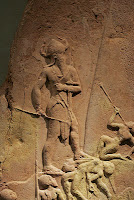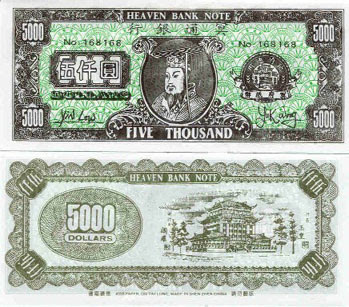The first...Mistress of the Animals.
"The idea of a Master or Mistress of the Animals who must be won over to the side of the hunters is widespread and very possibly Paleolithic in origin; in the official religion of the Greeks this survives at little more than the level of folklore." ( Greek religion: archaic and classical. Walter Burkert 1985. pp 172)The first,the very first Lady of the Underworld is described as "Mistress of the Animals". She is hard to name, belonging as she does to so very long, long ago.
My task was made more difficult because at first there seemed only a subtle difference between a *Mistress of Animals* who takes care of the wild animals and restores them to life, and the Earth-Lady whose sacrifice drives the plants out of the mud and into the light, as far as so many tellers of mythology are concerned.
And mythology is layer over layer, the stories I read concerning one goddess may be thousands of years apart.
When I first started thinking backwards I didn't think of the famous finds at Catal Hoyuk, nor did I recall Potnia Theron. I thought of Ereshkigal (Eres is Akkadian for *Nin* meaning Lady or Queen *Ki* means earth and *Gal* means Great).
Ereshkigal is "Great lady under earth" or "Queen of the great land" she is the goddess of Irkalla, the land of the dead or underworld. Sometimes her name is given as Irkalla, similar to way the name Hades was used in Greek mythology for both the underworld and its ruler.At first Ereshkigal didn't seem to me to be any kind of Persephone figure, it was Kramer who first mentioned the link in his book (Sumerian Mythology: Samuel Noah Kramer) in the chapter 'The Destruction of Kur: the Slaying of the Dragon'.
"It is the first of the three versions of the slaying of the dragon which seems to be the more original; the details of the story, few as they are, are significant and instructive. For in the first place, the battle between the god and Kur seems to take place not long after the separation of heaven and earth. Moreover, the crime involved is probably that of abducting a goddess; it therefore brings to mind the Greek story of the rape of Persephone. (Kramer.)The most famous story concerning Ereshkigal is The Descent of Inanna. In it, it is the male -Damuzi/Tammuz/Adonis figure followed by the young Lord's sister: Geshtinanna (or Ngeshtin-ana) who seem to be Persephone figures having to lie underground for periods of the year -Damuzi to fertilise the barley and Geshtinanna to fertilise the grapes. But the clues are there to indicate that Ereshkigal is an older Goddess, a 'Mistress of the Animals' or at least used to be.
The bull is often encountered in association with images of the Mistress of the Animals.
The reason Inanna gives for visiting her sister in the Great Below is to attend the funeral of Ereshkigal's consort, *The bull of Heaven* .
The Mistress of the Animals must always be giving birth.
Latter in the same story the kurgarra and galatur slip under the door to soothe Ereshkigal who is described as if she is giving birth. Now there is no reason within the story to understand why Ereshkigal should be described as if in labour, at first I thought that her distress was sorrow for what she had done to her sister, until I remebered that that the Mistress of Animals is always giving birth.
When this story was written the Mistress of the Animals had already become Queen of the Underworld and the motif of her labour was already obsolete for the dead now dissolved into ash...rather than return (unless as ghosts).
Ereshkigal does not offer re-birth by the time the Descent of Inanna was written.
But what stole Ereshkigal away? Kur is *mountain* but the words Kur and Hursag both denote mountains. The Kur is also foreign land and a threat, since the people of the mountainous countries were often at war with the cities of Sumer. Yet Kur may also be land in general; Sumer itself is described as kur-gal, "great land" the opposite to ki-gal "The Great-Below".
It is possible that the flames on escaping gas plumes in parts of the Zagros mountains would have given those mountains a meaning not entirely consistent with the primary meaning of mountains and an abode of a god.The Kur is also a dragon living between the land and the sweet waters of the abyss (the Absu)in this case the monster Kur would correspond to the latter (around 1100 BCE), dragon-like mother of the sweet water, Tiamat described in the Akkadian Enûma Eliš.
Ninhursag is more recognisable as the Mistress of Animals. In another story Ninurta the warrior kills the Kur:
What had been scattered, he gathered,His mother Ki (mother Earth) falls in love with him.Ninurta far from horrified looks at her with the "eye of life," saying
What by Kur had been dissipated,
He guided and hurled into the Tigris,
The high waters it pours over the farmland.
Behold now everything on earth
Rejoiced afar at Ninurta, the king of the land;
The fields produced much grain,
The harvest of palm-grove and vineyard was fruitful,
It was heaped up in granaries and hills;
The lord made mourning disappear from the land,
He made good the liver of the gods
:"O thou lady, because thou wouldst come to a foreign land,The Hursag brings forth everything needed for life: animals, plants, cheese, wine, gold and silver.
O Ninmah, because for my sake thou wouldst enter an inimical land,
Because thou hast no fear of the terror of the battle surrounding me,
Therefore, of the hill which I, the hero, have heaped up,
Let its name be Hursag (mountain), and thou be its queen."
But Ereshkigal is confined to the Great Below, like Persephone her duty is to make judgments and to be Queen of the dead...

